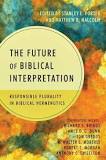 Thanks to IVP Academic for providing a review copy of Porter, Stanley E. and Matthew R. Malcolm, eds., The Future of Biblical Interpretation: Responsible Plurality in Biblical Hermeneutics (Downers Grove, IL: IVP Academic, 2013), 176pp.
Thanks to IVP Academic for providing a review copy of Porter, Stanley E. and Matthew R. Malcolm, eds., The Future of Biblical Interpretation: Responsible Plurality in Biblical Hermeneutics (Downers Grove, IL: IVP Academic, 2013), 176pp.
I offer the following review of this volume:
The Bible encompasses a plurality of voices, not only in genre but in perspective. And not surprisingly, interpreters of the Bible have generated a plurality of interpretations. How might biblical scholars work responsibly with and within this plurality? And what are the future directions or possibilities for biblical hermeneutics?
The essays in The Future of Biblical Interpretation originated in a conference held in honor of Anthony C. Thiselton, who is well known for his important work in hermeneutics and New Testament interpretation. After an opening essay by Thiselton on “The Future of Biblical Interpretation and Responsible Plurality in Hermeneutics,” the contributors look at the issues from a variety of angles—theological, scriptural, kerygmatic, historical, critical, ecclesial and relational. The result is an engaging conversation exploring responsible and productive interpretation of the Bible. A must-read for anyone seriously engaged in biblical scholarship today. [the preceding is from IVP Academic, see their press release: HERE]
CONTENTS:
Introduction
Stanley E. Porter and Matthew R. Malcolm
1. The Future of Biblical Interpretation and Responsible Plurality in Hermeneutics
Anthony C. Thiselton
2. Biblical Hermeneutics and Theological Responsibility
Stanley E. Porter
3. Biblical Hermeneutics and Scriptural Responsibility
Richard S. Briggs
4. Biblical Hermeneutics and Kerygmatic Responsibility
Matthew R. Malcolm
5. Biblical Hermeneutics and Historical Responsibility
James D. G. Dunn
6. Biblical Hermeneutics and Critical Responsibility
Robert C. Morgan
7. Biblical Hermeneutics and Relational Responsibility
Tom Greggs
8. Biblical Hermeneutics and Ecclesial Responsibility
R. Walter L. Moberly
Conclusion
Stanley E. Porter and Matthew R. Malcolm
Porter and Malcolm are to be commended for this very fine (and brief) volume. The contributors are all well-regarded in their own rights and many of the contributions offer helpful proposals for responsibility in Biblical interpretation. Essentially this volume proposes a sort of responsible “concordant polyphony” of interpretation (p.10). How these divergent voices are to be held in a sort of harmonic tension is another issue (as the editors note in their conclusion). The variant voices offered here tend toward a plurality of approaches to interpretation rather than simply a plurality of interpretations.
Chiefest of the contributions, from my perspective, were Anthony Thiselton’s open-ended suggestions for the future of Biblical interpretation and Richard Briggs’ Scriptural responsibility. Thiselton astutely notes that one cannot know the direction of Biblical interpretation despite seeing the directions it has taken and is taking. He thus refers to “future possibilities” rather than “future directions” (p.24). His “possibilities” are worth mentioning: (1) a genuine confluence between general hermeneutics and actual exegesis of Scripture, (2) the call to engage the text of Scripture as “Other” rather than simply self-reflection, (3) an equal weighting of the voices of Scripture, (4) a move beyond the greatest extremes of interpretive theory, (5) continued appropriation and development of Speech-Act Theory, and (6) a proper use of literary theories in hearing the voice/s of Scripture.
Briggs’ chapter proposes “four specific theological construals of Scripture that might productively frame Christian wrestling with hermeneutical plurality: two testaments, in a creative set of theological tensions, as a means of grace, and held together dialogically as the communicative acts of the one God who is the God of Abraham, Isaac and Jacob, and also the God of our Lord Jesus Christ” (p.69). This is his manner of proposing a Christian reading of the Scriptures we hold by faith and confession. He argues it is not a responsible reading that thinks one should read apart from their commitment of faith to God in Christ as confessed by all the Church everywhere. This is, to my thinking, imperative for Christian interpreters of Scripture. Walter Moberly seems to offer a similar stream of thought within the framework of “canon”. His contribution might equally offer a helpful aim for understanding responsible Christian interpretation of the texts gathered and affirmed as authoritative for and by the Church.
Along a similar trajectory is Malcolm’s contribution. He argues for a “primed” and “faithful” interpreter (pp.81-84). This is understood to be an interpreter who holds the public confession of Christ as Lord as central to responsible interpretation of Scripture. Tom Greggs (Relational Responsibility), more specifically, speaks to a Protestant hearing of Sola Scriptura grounded in his understanding of the ecumenical creeds of the early centuries.
Less helpful contributions by James Dunn (historical responsibility) and Stanley Porter (theological responsibility) are also worth mentioning. (My appraisal of their work may be tangential to my own perspective on other related issues). Dunn offers a fine reminder of the situatedness of the Biblical texts (or any text for that matter) as well as of the interpreter. This is a necessary reminder. He does, however, seem to offer essentially his own (once again) offering of a re-reading of Paul in the strain of the “new perspective”. In this sense, I find him helpful and unhelpful. His methodology being helpful, his conclusions less than. Robert Morgan (Critical Responsibility), likewise, argues from a more thorough-going historical-critical perspective from within his own understanding of a NT theological perspective particularly with regard to the descriptions of the Jesus of history and Christ of faith.
The reason I do not find Porter’s chapter to be as helpful as others might be his (seemingly) over negative appraisal of theological interpretation in its contemporary trending. He argues for a “Biblical hermeneutic” against simply a “Biblical interpretation”. The former referring to the broader notions of theory and the latter to specific approaches to the text (or at least that is how I understand his approach). Hermeneutics is broad (entailing the interpreter as well), while interpretation is supposedly narrow and involves “processes and techniques” (p.31). I appreciate his attempts to delineate the two, but perhaps this is nuancing in ways others here have not and might themselves find unfruitful. Following his trajectory, he proposes a theological hermeneutic against a theological interpretation. Again, I find certain aspects of his approach to be helpful, while also seeming to be overly critical apart from a genuine appraisal of specifics. [Perhaps what is really needed is my own further interaction with other writings of Porter to better grapple with his approach]
Perhaps one of the most poignant comments for many of those who might make use of a volume like this was Walter Moberly’s personal narrative interwoven within his discussion of Ecclesial Responsibility:
“the way the Bible is taught in divinity schools and seminaries in the US…[is] not fit for [the ecclesial purpose of producing] future leaders of churches who will spend much time reading and interpreting Biblical texts, can finish their studies and still be relatively clueless about how to handle these texts well in the situations in which they find themselves” (p.134, referring to the comparable appraisal of Dale B. Martin, Pedagogy of the Bible: An Analysis and Proposal [Louisville and London: Westminster John Knox, 2008]).
That is a danger, all too real, that it would be hoped The Future of Biblical Interpretation might aid in remedying in part by at least raising the imperative questions of (as the subtitle claims) responsible plurality in Biblical hermeneutics. This is a welcome volume that should be incorporated into hermeneutic reading requirements for graduate level courses in Biblical hermeneutics and it is a fine praise to the tremendous contributions of the scholarship of Anthony Thiselton.
_____________
See what other reviewers have to say:
Nate Claiborne
Jim West (forthcoming)







